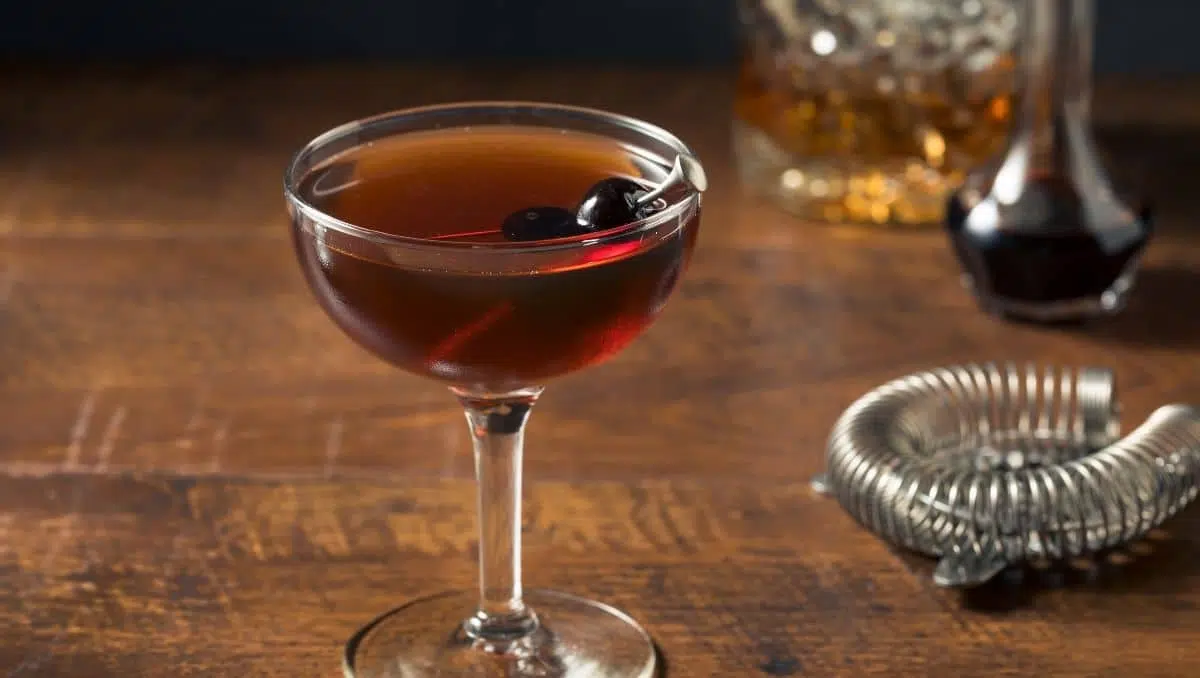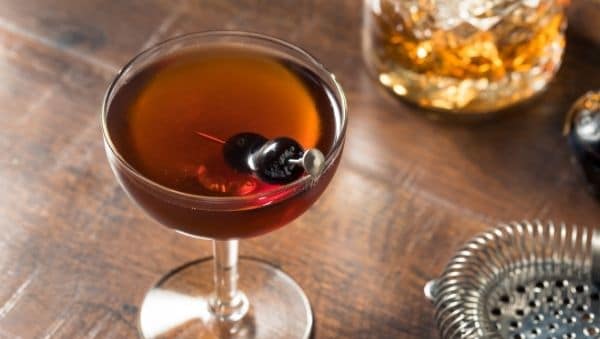This cocktail recipe owes its name to the colors of its three ingredients: Bijou is the French term for jewel, so Harry Johnson chose the name for his boozy creation because each element reflects the color of a popular gemstone:
The gin part stands for diamond, sweet vermouth for ruby, and green Chartreuse for emerald.
Quick Facts Bijou Cocktail
- Method: stirred
- Flavor profile: boozy, dry, herbaceous
- How to serve it: straight up
- Glassware: coupe glass, Nick & Nora
- Alcohol content: ~ 30% ABV, 28 grams of alcohol per serving
The Bijou has a long history that goes back about 130 years. However, unlike other classic cocktails, it took quite some time after prohibition ended until the recipe was rediscovered.

Equipment
- 1 Jigger
- 1 Mixing glass
- 1 Hawthorne Strainer
Ingredients
- 1.5 oz Plymouth Gin
- ¾ oz Sweet Vermouth
- ¾ oz Green Chartreuse
- 1 dash Orange cocktail bitters - optional
Instructions
- Add all ingredients into a mixing glass with ice.1.5 oz Plymouth Gin, ¾ oz Sweet Vermouth, ¾ oz Green Chartreuse, 1 dash Orange cocktail bitters
- Stir until the drink is well-chilled, and then strain into a chilled Nick & Nora glass.
- Garnish with Maraschino cherry, lemon peel, or both.
Nutrition
Ingredients with Recommendations
The three traditional elements of a Bijou recipe are Plymouth Gin, Green Chartreuse, and sweet vermouth. The gin part is not set in stone, but the other two components are a fixture:
- Gin: Plymouth Gin works perfectly, but in various contemporary recipes, you can find other types of gin. A traditional London Dry or dry gin are common substitutes. If you like a sweeter flavor, try Old Tom Gin.
- Vermouth: Vermouth is a French fortified wine infused with different herbs and botanicals. Contrary to what the red color of Sweet Vermouth suggests, it is based on white wine. Martini Rosso is a standard option. Yet, if you want something more refined, take Carpano Antica Formula Vermouth. It is one of my favorite vermouths.
- Green Chartreuse: Green Chartreuse is another French herbal liqueur based on wine. It goes back to an ancient recipe invented by a monk. It's infused with an incredible 130 herbs and spices and has a distinct green color and an ABV of 55%.
- Bitters are optional: you can add a dash of orange cocktail bitters to the mix to create a more complex flavor profile.
- Garnish: Garnish your cocktail with either lemon peel or Maraschino cherries. Both garnishes are mentioned in the original recipe and work brilliantly. You can also use both and skewer them on a cocktail pick.
Tips & Tricks
There are just two small things to keep in mind to get a perfect, bar-quality drink. Our first tip is to chill the glass before pouring the drink. The Bijou Cocktail is served without ice, and you want the drink to keep its temperature for as long as possible.
Also, when preparing your cocktail, put plenty of ice cubes in your mixing glass and stir for at least 25 seconds. This cocktail packs a punch and needs some dilution from the melting ice.
Bijou Recipe Variations
We prefer the variation you can find in our Bijou recipe above, the 2:1:1 approach: Two parts gin, mixed with one part vermouth and one part Green Chartreuse.
The original recipe with Green Chartreuse suggested an equal-parts approach that you rarely see on today's bar menus.
Further, there is Dale DeGroff's modern version, pulling back on the Green Chartreuse and using three parts gin, one part vermouth, and one part Green Chartreuse.
And there is one more variation you might want to try:
The very first version published by C.F. Lawlor went in a different direction. He also suggested equal parts, but instead of using Green Chartreuse, he opted for Grand Marnier. And while Grand Marnier is a great cocktail ingredient, this version of the Bijou recipe never became that popular.

History of the Bijou Cocktail
The recipe of the Bijou cocktail goes back to the 1890s. Shortly after its first appearance in a bar, mixologist C.F. Lawlor was the first to publish the cocktail recipe.
A few years later, in 1900, the drink would be publicized in written form by its creator, US bartender Harry Johnson. It was part of his book - New and Improved Bartender Manual.
In his original recipe, Johnson asks for equal parts of gin, sweet vermouth, and Green Chartreuse. For decades, this version has been a popular choice in countless bars.
However, with the start of prohibition in 1920, the popularity of the Bijou Cocktail naturally declined. When the transport and serving of alcohol finally were legal again, the recipe was forgotten - almost.
Decades later, famous bartender and renowned cocktail expert DeGroff browsed Harry Johnson's book when he discovered the Bijou cocktail.
Inspired by the list of ingredients, he tried the recipe. Yet, what he tasted was an overwhelming and unbalanced flavor of Green Chartreuse. To fix that, he changed the traditional recipe. DeGroff's improved formula consists of three parts gin, one part vermouth, and one part Green Chartreuse.
Today you'll rarely get a traditional version of the Bijou cocktail. You will get either a drink based on DeGroff's recipe or another tweaked version.
Related Cocktails
The original equal-parts recipe based on gin and vermouth is reminiscent of an Italian classic, the Negroni. But there are more drinks not too far off in style and flavor.
- The Martinez - a forerunner of the Martini cocktail and a bold gin cocktail that's mixed with sweet vermouth and Maraschino liqueur.
- The Negroni: This classic Italian cocktail, also called the King of Cocktails, is simple yet flavorful with gin, sweet vermouth, and Campari.
- The White Negroni - a twist that also reminds of the formula for the Bijou cocktail. This recipe asks for gin, dry vermouth, and Lillet Blanc.
- Last but not least: The Last Word - another traditional cocktail related to the Bijou. A three-ingredient cocktail made of gin, Green Chartreuse, and Maraschino liqueur.
